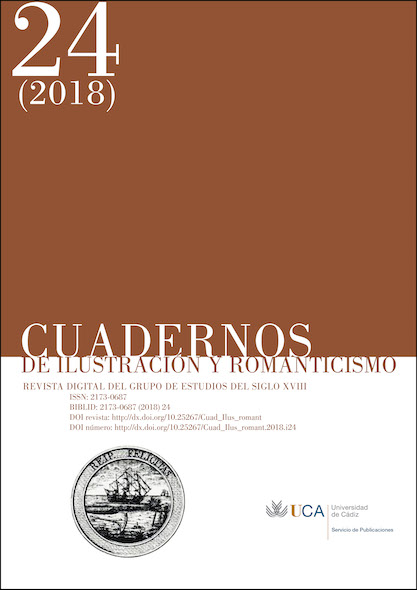Pictures of a heterogeneous revolution. Tensions between text and image in The marriage of heaven and hell of William Blake

DOI
https://doi.org/10.25267/Cuad_Ilus_romant.2018.i24.27Info
Abstract
William Blake’s illuminated books are particular art objects that combine image and text in an etching technique created by the artist. They create the illusion of handwriting, whose stroke continues in drawing. The Marriage of Heaven and Hell [ca. 1790] is an inflection point among these books, because it shows a reinforcement of the technique, respecting the quality of images and the readability of handwriting, and because plate 15 symbolizes the illuminating process. Despite the visual illusion, the piece does not generate a continuous sense, but image and text are in tension. This study focuses on the complex interpretation of this piece as a literary and artistic work that comprises a counter-reflexive idea of time and history.
Keywords
Downloads
How to Cite
License

This work is licensed under a Creative Commons Attribution-NonCommercial-NoDerivatives 4.0 International License.
The papers published in this journal are the property of Cuadernos de Ilustración y Romanticismo: the source must be cited whenever they are used.
The authors retain the copyright © and grant the journal the right to publish. They may host their work in the final published version on personal websites or websites intended for scientific dissemination, provided that they indicate the source.
References
ARENDT, Hannah (1988), «El significado de la revolución», en Sobre la revolución, Madrid, Alianza, pp. 21-59.
BENJAMIN, Walter (1990), El origen del drama barroco alemán, Madrid, Taurus.
BENJAMIN, Walter (2005), El libro de los pasajes, Madrid, Akal.
BLAKE, William (2002), El matrimonio del cielo y el infierno, Madrid, Cátedra.
BLAKE, William (1994), The Marriage of Heaven and Hell. In Full Color, Dover, Dover Publications.
BLOOM, Harold (1999), La Compañía Visionaria. William Blake, Buenos Aires, Adriana Hidalgo Editora.
CASTANEDO, Fernando (2002), «Introducción», en William Blake, El matrimonio del cielo y el infierno. Madrid, Cátedra, pp. 9-54.
DIDI-HUBERMAN, Georges (2011), Ante el tiempo. Historia del arte y anacronismo de las imágenes, Buenos Aires, Adriana Hidalgo Editora.
ERDMAN, David V. (ed.) (2008), The Complete Poetry and Prose of William Blake, Berkeley – Los Ángeles – Londres, University of California Press.
FOUCAULT, Michel (2012), Esto no es una pipa. Ensayo sobre Magritte, Buenos Aires, Eterna Cadencia.
FRYE, Northrop (2011), «El ladrón del fuego», Buenos Aires, FFyL-UBA, (mimeo). Traducción de Mario Rucavado Rojas para la Cátedra de Literatura del Siglo XIX.
FRYE, Northrop (1947), Fearful Symmetry. A Study of William Blake, Boston, Beacon Press.
GABRIELONI, Ana Lía (2007), «Imágenes de la traducción y relaciones interartísticas», Revista de Historia de la Traducción, nº 1, s. p.. Disponible: https://goo.gl/QWkmRn
JAUSS, Hans Robert (1995), «Los mitos del comienzo: una oculta nostalgia de la Ilustración», en Las transformaciones de lo moderno. Estudio sobre las etapas de la modernidad estética, Madrid, Visor.
LEDESMA, Jerónimo y Valeria CASTELLÓ-JOUBERT (coords.) (2012), Revolución y literatura en el siglo diecinueve. Fuentes, documentos y textos críticos, Buenos Aires, Editorial de la Facultad de Filosofía y Letras – Universidad de Buenos Aires, tomo I.
MAKDISI, Saree (2003), William Blake and the Impossible History of the 1790s, Chicago – Londres, The University of Chicago Press.
MITCHELL, William John Thomas (1987), Iconology: Image, Text, Ideology, Londres, The University of Chicago Press.
PEVSNER, Nikolaus (2000), Pioneros del diseño moderno. De William Morris a Walter Gropius, Buenos Aires, Ediciones Infinito.
QUINNEY, Laura (2009), William Blake on Self and Soul, Londres, Harvard University Press.
SHOCK, Peter (2012), «El matrimonio del cielo y el infierno: el mito de Satán en Blake y su matriz cultural», en Jerónimo Ledesma y Valeria Castelló-Joubert (coords.), Revolución y literatura en el siglo diecinueve. Fuentes, documentos y textos críticos, Buenos Aires, Editorial de la Facultad de Filosofía y Letras – Universidad de Buenos Aires, tomo i, pp. 185-228.
SUNG, Mei-Ying (2009), William Blake and the Art of Engraving, Londres, Pickering & Chatto.
THOMPSON, E. P. (1993), Witness against the Beast. William Blake and the Moral Law, Nueva York, The New Press.
VISCOMI, Joseph (2012), «En las cuevas del cielo y el infierno: Swedenborg y la impresión en El matrimonio de Blake», en Jerónimo Ledesma y Valeria Castelló-Joubert (coords.), Revolución y literatura en el siglo diecinueve. Fuentes, documentos y textos críticos, Buenos Aires, Editorial de la Facultad de Filosofía y Letras – Universidad de Buenos Aires, tomo i, pp. 229-268.
VISCOMI, Joseph (2002), «William Blake’s Illuminated Printing», en Eaves Morris (ed.), Cambridge Companion to William Blake. Cambridge, Cambridge University Press, pp. 37-62.
VISCOMI, Joseph (1998), «Lessons of Swedenborg: or, the Origin of Blake’s The Marriage of Heaven and Hell [Part ii. of The Evolution of William Blake’s The Marriage of Heaven and Hell]», en Robert Gleckner y Thomas Pfau, Lessons of Romanticism. Durham, Duke University Press, pp. 173-212.
VISCOMI, Joseph (1995), «The Evolution of The Marriage of Heaven and Hell». The Huntington Library Quarterly, Vol. 58, nº 3/4, William Blake: Images and Texts, pp. 281-344.
VISCOMI, Joseph (s. f.), «Blake’s Invention of Illuminated Printing, 1788», en Dino Franco Felluga (ed.), BRANCH: Britain, Representation and Nineteenth-Century History. Extension of Romanticism and Victorianism on the Net, s. p. Disponible: https://goo.gl/Xdr4N6
WELCH, Andrew (2010), «Text, Image, Book: Reading William Blake». Disponible: goo.gl/bs4Eyv






